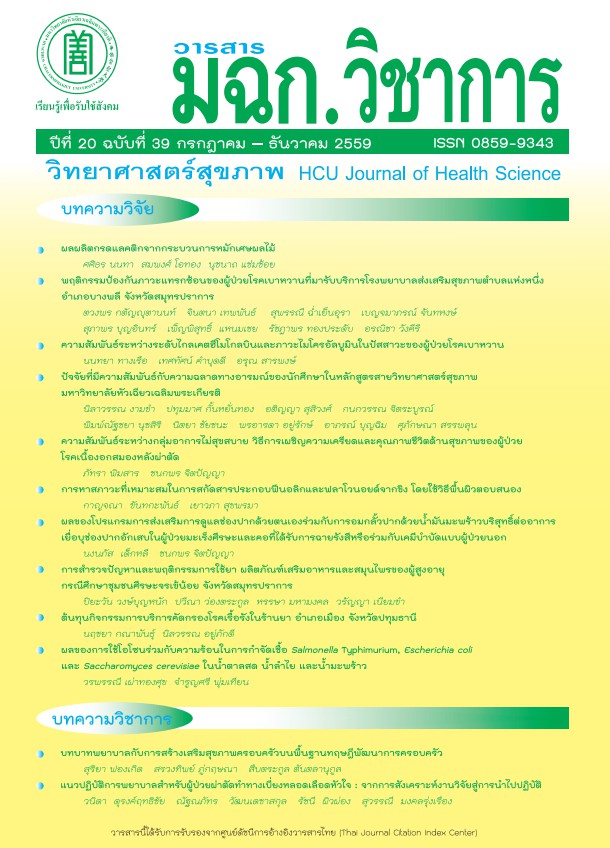ผลของการใช้โอโซนร่วมกับความร้อนในการกำจัดเชื้อ Salmonella Typhimurium, Escherichia coli และ Saccharomyces cerevisiae ในน้ำตาลสด น้ำลำไย และน้ำมะพร้าว
คำสำคัญ:
โอโซน, เชื้อก่อโรคทางเดินอาหาร, เครื่องดื่ม, น้ำตาลสด, น้ำลำไย, น้ำมะพร้าวบทคัดย่อ
วัตถุประสงค์ของงานวิจัยนี้คือการทดลองใช้โอโซนร่วมกับอุณหภูมิในการกำจัดแบคทีเรีย (Salmonella Typhimurium และ Escherichia coli) และยีสต์ (Saccharomyces cerevisiae) ใน น้ำตาลสด น้ำลำไย และน้ำมะพร้าว ที่ความหนาแน่นเชื้อเริ่มต้น 107 CFU ต่อมิลลิลิตร โดยหลังจาก เติมหัวเชื้อแบคทีเรียหรือยีสต์ลงในน้ำหวานผลไม้ปริมาตร 1 ลิตร ได้พ่นโอโซนความเข้มข้น 300 มิลลิกรัมต่อชั่วโมง ด้วยอัตรา 2.5 ลิตรต่อนาที โดยทดลองในอุณหภูมิแตกต่างกัน ได้แก่ อุณหภูมิต่ำ (4 องศาเซลเซียส) อุณหภูมิสูง (50 องศาเซลเซียส) และอุณหภูมิห้อง (30 องศาเซลเซียส) โดยใช้ การพ่นอากาศที่ผ่านการกรองกำจัดเชื้อแล้วเป็นชุดควบคุม ผลการทดลองพบว่า โอโซนสามารถยับยั้ง แบคทีเรียและยีสต์ในเครื่องดื่มน้ำหวานทั้ง 3 ชนิดได้ โดยมีผลลดจำนวนเชื้อลงระหว่าง 1.2 - 6.5 log CFU ต่อมิลลิลิตร การลดหรือเพิ่มอุณหภูมิจะช่วยเพิ่มประสิทธิภาพการกำจัดจุลินทรีย์ของโอโซนได้ โดยโอโซน มีประสิทธิภาพในการยับยั้ง Salmonella Typhimurium และ Escherichia coli ได้ในระดับใกล้เคียงกัน แต่ยีสต์ Saccharomyces cereviseae มีความทนทานต่อโอโซนมากกว่า สภาวะที่ดีที่สุดในการยับยั้งแบคทีเรียและยีสต์ คือ การใช้โอโซนร่วมกับอุณหภูมิสูง (50 องศาเซลเซียส) ซึ่งจะลดจำนวนเชื้อลงได้ มากกว่า 7 log CFU ต่อมิลลิลิตร
Downloads
References
จังหวัดมหาสารคาม” วารสารวิจัยสาธารณสุขศาสตร์ มหาวิทยาลัยขอนแก่น. 5 (3) หน้า 87-96.
Abid, M. et al. (November 2014) “Synergistic impact of sonication and high hydrostatic pressure on microbial and enzymatic inactivation of apple juice” LWT - Food
Science and Technology. 59 page 70-76.
Broadwater, W. T., Hoehn, R. C. and King, P. H. (September 1973) “Sensitivity of three selected bacterial species to ozone” Journal of Applied Microbiology. 26 page
391-393.
Buchanan, R. L. et al. (November 1998) “Inactivation of Escherichia coli O157:H7 in apple juice by irradiation” Apply and Environmental Microbiology. 64 page 4533-
4535.
Chavasit, V., Kunhawattana, S. and Jirarattanarangsri, W. (August 2006) “Production and contamination of pasteurized beverages packed in sealed plastic containers in
Thailand and potential preventive measures” Food Control. 17 page 622-630.
Choi, M. R. et al. (October 2012) “Inactivation of Escherichia coli O157:H7, Salmonella Typhimurium and Listeria monocyotgenes in apple juice with gaseous ozone”
Food Microbiology. 32 page 191-195.
Guzel-Seydim, Z. B., Greene, A. K. and Seydim, A. C. (June 2004) “Use of ozone in the food industry” Lebensm.-wiss. u.-Technol. 37 page 453-460.
Kim, J., Yousef, A. E., and Khadre, M. A. (September 2003) “Ozone and its current and future application in the fooindustry” Advances in Food and Nutrition
Research. 45 page 167-218.
Moore, G., Griffith, C. and Peters, A. (August 2000) “Bactericidal properties of ozone and its potential application as a terminal disinfectant” Journal of Food Protection.
63 (8) page 100-1106.
Patil, S. et al. (September 2010) “Inactivation of Escherichia coli by ozone treatment of apple juice at different pH levels” Food Microbiology. 27 page 835-840.
Restaino, L. et al. (September 1995) “Efficacy of ozonated water against various foodrelated microorganisms” Applied and Environmental Microbiology. 61 (9) page
3471-3475.
Sung, H. J. et al. (February 2014) “Combination effect of ozone and heat treatments for the inactivation of Escherichia coli O157:H7, Salmonella Typhimurium, and Listeria
monocytogenes in apple juice” International Journal of Food Mirobiology. 171 page 147-153.
Tiwari, B. K. et al. (April 2009) “Effect of ozone processing on anthocyanins and ascorbic acid degradation of strawberry juice” Food chemistry. 113 page 1119-1126.
Torlak, E. (February 2014) “Efficacy of ozone against Alicyclobacillus acidoterrestris spores in apple juice” International Journal of Food Microbiology. 172 page 1-4.
Ukuku, D. O. and Geveke, D. J. (March 2010) “A combined treatment of UV-light and radio frequency electric field for the inactivation of Escherichia coli K-12 in apple
juice” International Journal of Food Microbiology. 138 page 50–55.
U.S. Food and Drug Administration. (January 2001) “Hazard analysis and critical point (HACCP); procedures for the safe and sanitary processing and importing of juice;
final rule” Federal Register. 66 page 6138.
U.S. Food and Drug Administration. (2000) Bacteriological Analytical Manual (BAM) (8th ed.). [Online] Available : http://www.fda.gov/BAM (25 July 2009)
Williams, R. C., Summer, S. S. and Golden, D. A. (November 2004) “Survival of Escherichia coli O157:H7 and Salmonella in apple cider and orange juice as a affected
by ozone and treatment temperature” Journal of Food Protection. 67 page 2381-2386.
Downloads
เผยแพร่แล้ว
How to Cite
ฉบับ
บท
License
บทความที่ได้รับการตีพิมพ์เป็นลิขสิทธิ์ของวารสารวิทยาศาสตร์สุขภาพและสุขภาวะ
ข้อความที่ปรากฏในบทความแต่ละเรื่องในวารสารวิชาการเล่มนี้เป็นความคิดเห็นส่วนตัวของผู้เขียนแต่ละท่านไม่เกี่ยวข้องกับมหาวิทยาลัยหัวเฉียวเฉลิมพระเกียรติ และคณาจารย์ท่านอื่นๆในมหาวิทยาลัยฯ แต่อย่างใด ความรับผิดชอบองค์ประกอบทั้งหมดของบทความแต่ละเรื่องเป็นของผู้เขียนแต่ละท่าน หากมีความผิดพลาดใดๆ ผู้เขียนแต่ละท่านจะรับผิดชอบบทความของตนเองแต่ผู้เดียว



